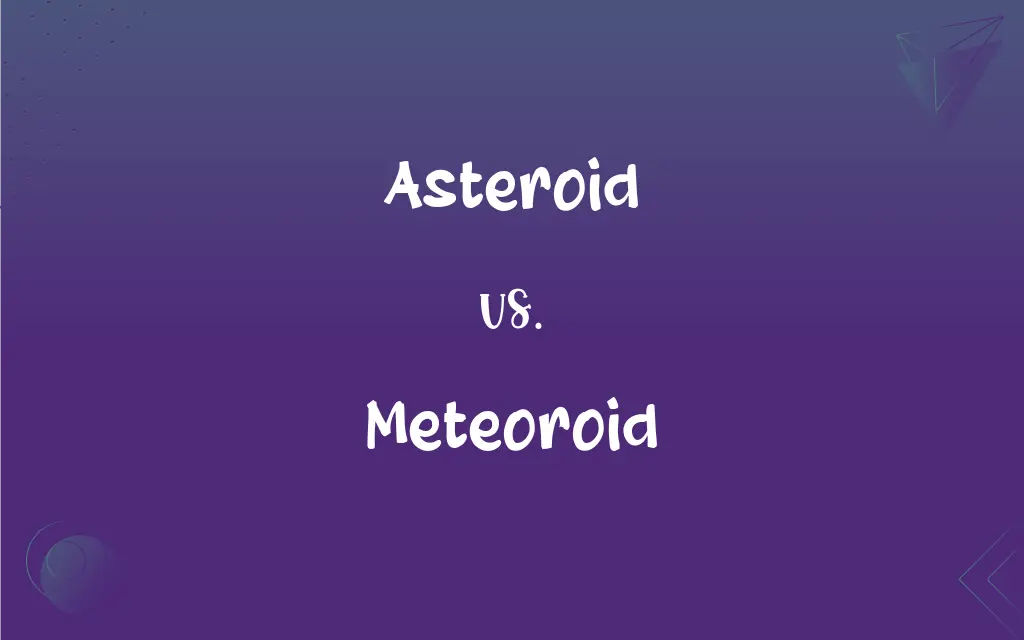Asteroid vs. Meteoroid: What's the Difference?
Edited by Janet White || By Harlon Moss || Updated on October 14, 2023
Asteroids are rocky bodies in space, primarily found in the asteroid belt between Mars and Jupiter, while meteoroids are smaller objects, often from asteroid or comet debris, that can collide with Earth and other planets.

Key Differences
Asteroids, orbiting primarily between Mars and Jupiter, represent leftover building materials from the formation of the solar system about 4.6 billion years ago. Contrarily, meteoroids are considerably smaller, often originating from asteroids and comets, providing valuable insights into the ancient solar system. The dimension distinction plays a pivotal role in differentiating these celestial entities.
The exploration and study of asteroids, like Vesta or Ceres, allow scientists to delve into the past, providing a glimpse into the conditions prevailing in the early solar system. On the other hand, meteoroids, when entering a planet’s atmosphere, metamorphose into meteors, popularly known as shooting stars, which are not stars at all, offering spectacular streaks of light across the night sky. The study and observation of these phenomena enlighten researchers about the constituents of space objects.
Asteroids can span hundreds of kilometers in diameter and have even been contemplated for potential future human habitation. On the contrary, meteoroids, significantly smaller and sometimes only the size of a grain of dust, rarely reach a planet’s surface intact, often disintegrating upon atmospheric entry, leaving only a brilliant trail of heated air molecules and ionized gas. While asteroids have potential for scientific exploration, meteoroids enchant skygazers with sporadic and meteor shower displays.
The existence of asteroids in the asteroid belt illustrates a boundary in our solar system, presenting a division between the rocky planets and the gas giants. In contrast, meteoroids, sometimes colliding with Earth, have been contributing to our planet's mass, albeit very minutely, and have been shaping its surface for billions of years. Both celestial bodies, albeit distinct, influence planetary science and terrestrial dynamics.
Asteroids and meteoroids, notwithstanding their size discrepancies, facilitate scientific exploration, offer celestial spectacles, and intertwine with the historical and evolutionary narratives of our solar system and Earth. The study and exploration of these celestial entities pave pathways towards understanding our place in the universe and the historical celestial mechanics that have sculpted our world and solar system.
ADVERTISEMENT
Comparison Chart
Size
Generally larger, can be hundreds of kilometers in diameter.
Considerably smaller, often just the size of a grain of sand.
Origin & Location
Primarily found in the asteroid belt.
Can originate from asteroids or comets, found throughout space.
Impact on Earth
Rarely impact Earth due to their larger size and location.
Can enter Earth’s atmosphere, becoming meteors.
Scientific Significance
Studied to understand the solar system’s formation.
Provide insights into the composition of asteroids and comets.
Visible Phenomena
Generally not visible without a telescope.
Can create visible streaks of light (meteors) in the night sky.
ADVERTISEMENT
Asteroid and Meteoroid Definitions
Asteroid
Asteroids are rocky, airless remnants left over from the early formation of our solar system.
The asteroid belt contains numerous rocky bodies, such as Ceres, which orbit the Sun between Mars and Jupiter.
Meteoroid
Meteoroids are small rocky or metallic objects in outer space that are significantly smaller than asteroids.
The meteoroid, before entering Earth’s atmosphere, was a mere speck in the vastness of space.
Asteroid
Most asteroids are irregular in shape because they too small to exert enough gravity to become circular.
The asteroid Eros has a peanut-like shape, demonstrating the irregular forms these celestial bodies can take.
Meteoroid
Meteoroids that survive the journey through the atmosphere and reach a planet’s surface are called meteorites.
After the meteoroid successfully passed through the atmospheric barrier, it landed on Earth, becoming a meteorite.
Asteroid
They can range in size from tiny rocks to objects that are 940 kilometers (about 583 miles) in diameter.
Vesta, one of the largest asteroids, has a diameter of about 525 kilometers (about 326 miles).
Meteoroid
Meteoroids can vary in size from tiny particles to boulders weighing several tonnes.
Despite its impressive light display upon entry, the meteoroid was no larger than a small pebble.
Asteroid
Asteroids can have moons and can also be found in groups or pairs that orbit each other.
The asteroid Ida has its own moon, Dactyl, which orbits it as they travel through space together.
Meteoroid
Meteoroids originate from comets or asteroids and can be on a collision course with Earth.
The meteoroid, once a part of an asteroid, detached and traveled through space, potentially towards Earth.
Asteroid
Some asteroids have even been found to have a small companion moon (some have two moons).
In 2017, astronomers discovered that the asteroid Florence, which passed by Earth, has two small moons orbiting it.
Meteoroid
When meteoroids enter a planet’s atmosphere, they begin to burn up, creating visible streaks in the sky known as meteors.
The meteoroid transformed into a bright meteor as it streaked through the night sky, offering a brief yet stunning spectacle.
Asteroid
(Astronomy) Any of numerous small solar system bodies that revolve around the sun, with orbits lying chiefly between Mars and Jupiter and characteristic diameters roughly between one and several hundred kilometers. Also called minor planet, planetoid.
Meteoroid
A solid body, moving in interplanetary space, that is smaller than an asteroid and at least as large as a speck of dust.
Asteroid
(Zoology) See starfish.
Meteoroid
(astronomy) A relatively small (sand- to boulder-sized) fragment of debris in a star system that produces a meteor when it hits the atmosphere
Meteoroid
A small body moving through space, or revolving about the sun, which on entering the earth's atmosphere would be deflagrated and appear as a meteor.
These bodies [small, solid bodies] before they come into the air, I call meteoroids.
Meteoroid
(astronomy) any of the small solid extraterrestrial bodies that hits the earth's atmosphere
FAQs
Can asteroids have moons?
Yes, some asteroids have their own moons.
Are asteroids potential threats to Earth?
Yes, some asteroids can be potential threats, but most do not intersect with Earth's orbit.
What are meteor showers?
Meteor showers occur when Earth passes through the debris left by a comet, creating numerous meteors.
Are meteoroids remnants of the early solar system?
Yes, meteoroids, like asteroids, are remnants from the early formation of the solar system.
Where are most asteroids located?
Most asteroids are located in the asteroid belt between Mars and Jupiter.
What is a meteoroid?
A meteoroid is a small rocky or metallic body in outer space, significantly smaller than an asteroid.
Can meteoroids be dangerous to Earth?
Generally, meteoroids burn up in the atmosphere, but larger ones that reach Earth’s surface can cause damage.
How big are meteoroids?
Meteoroids can range from the size of a grain of sand to boulders weighing several tonnes.
Where do meteoroids come from?
Meteoroids often originate from comets or asteroids.
Have asteroids ever collided with planets?
Yes, asteroids have collided with planets, including Earth, in the past.
Is it possible to mine asteroids?
Yes, asteroid mining is theoretically possible and is being explored as a future endeavor.
Are meteoroids found near Earth?
Yes, some meteoroids are found near Earth and are called near-Earth objects.
What is the composition of asteroids?
Asteroids can be composed of rock, metal, or a combination of both.
Can meteoroids become meteorites?
Yes, if a meteoroid survives its passage through the atmosphere and lands on Earth, it is termed a meteorite.
Can asteroids collide with Earth?
Yes, asteroids can collide with Earth, though large impacts are rare.
What is an asteroid?
An asteroid is a rocky body that orbits the Sun, primarily found between Mars and Jupiter.
What happens when a meteoroid enters Earth's atmosphere?
A meteoroid becomes a meteor, burning and creating a visible streak in the sky.
How are asteroids studied?
Asteroids are studied using telescopes and by sending spacecraft for closer investigation.
Can meteoroids originate from the Moon or Mars?
Yes, meteoroids can be ejected from the Moon or Mars due to asteroid impacts.
What causes meteoroids to glow as meteors?
Meteoroids glow due to intense friction and heating as they enter a planet's atmosphere.
About Author
Written by
Harlon MossHarlon is a seasoned quality moderator and accomplished content writer for Difference Wiki. An alumnus of the prestigious University of California, he earned his degree in Computer Science. Leveraging his academic background, Harlon brings a meticulous and informed perspective to his work, ensuring content accuracy and excellence.
Edited by
Janet WhiteJanet White has been an esteemed writer and blogger for Difference Wiki. Holding a Master's degree in Science and Medical Journalism from the prestigious Boston University, she has consistently demonstrated her expertise and passion for her field. When she's not immersed in her work, Janet relishes her time exercising, delving into a good book, and cherishing moments with friends and family.































































